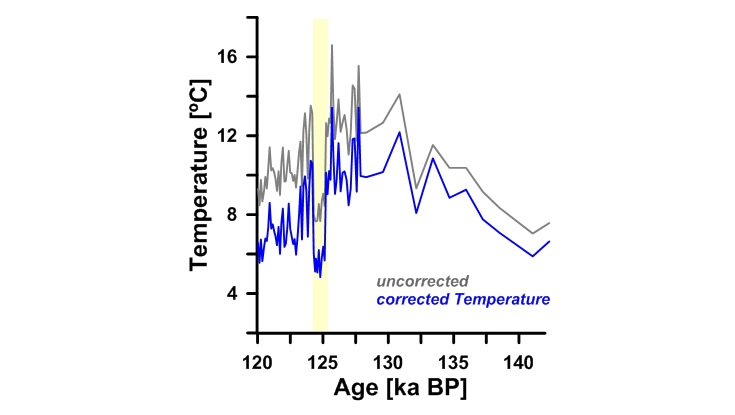
A modified figure showing the underestimation of reconstructed temperatures for the last interglacial (warm) period. Photo: NUI Galway
A new study led by Dr Audrey Morley at NUI Galway, has found that the magnitude of past abrupt climate change events may have underestimated. If so, the impact of current climate change may be larger than expected. The study was published today (4 December 2017) in the international journal Geochemistry, Geophysics, Geosystems.
Lead author of the study, Dr Audrey Morley from the School of Geography and Archaeology at NUI Galway, said: “Abrupt climate events that occurred during the last interglacial (warm) period, ca. 125,000 years ago, have been underestimated by up to 4°Celsius. This is important because our current understanding of climate change and our predictions of future climate both rely on past examples from Earth’s climate history. Robust and quantitative methods to deduce the magnitude of abrupt climate events from the geologic record are therefore essential.”
In this new study, Dr Morley collaborated with researchers from the University of California-Santa Cruz, Rutgers University New Jersey and the University of Bergen, and studied an established geochemical tool for investigating sea surface temperatures in the past. In the modern ocean, observations have shown that marine plankton (foraminifera) will use more magnesium relative to calcium, which are elements freely available in sea water, when they form their shell in warmer waters. This allows scientists to apply this modern relationship between magnesium, calcium, and temperature to the past by measuring magnesium-to-calcium ratios (Mg/Ca) in fossilised marine plankton that are continually deposited in seafloor sediments. However, there are limitations with the Mg/Ca temperature relationship, because the scientists understanding of other processes that may influence the amount of magnesium in the shell is incomplete.
For example, higher carbon dioxide levels in seawater results in lower pH (potential of hydrogen) and lower carbonate ion concentrations. Carbonate ion is the carbon species used by foraminifera to form their calcium carbonate tests. As carbonate ion becomes less available in surrounding seawater the individual organism needs to exert more energy for calcification. Through this process more magnesium becomes incidentally incorporated than what would be predicted by temperature only. Since colder surface waters absorb more carbon dioxide than warmer waters, this leads to generally low carbonate ion concentrations in cold surface waters. Therefore, when magnesium-to-calcium values are measured on fossilised marine plankton that lived in surface waters with low carbonate ion concentrations, this relationship leads to an underestimation of reconstructed temperatures.
This study presents an innovative mathematical correction scheme that enables the carbonate ion concentration effect to be isolated from the temperature signal recorded in marine plankton (from magnesium-to-calcium ratios) via subtraction. Specifically, Dr Morley and her colleagues were able to quantify the control of low carbonate ion concentrations values on magnesium-to-calcium ratios for a specific marine plankton species (Neogloboquadrina Incompta) living in the subpolar North Atlantic Ocean, and thereby isolate the true magnesium-to-calcium temperature relationship.
Dr Morley added: “Applying the proposed correction scheme to past climate records reveals that we may have underestimated abrupt climate events by up to 4°Celsius during past interglacial (warm) periods. This is particularly important for climate records from the subpolar/polar North Atlantic region that may have experienced abrupt changes in carbonate ion concentrations linked with abrupt climate events. Correcting for low carbonate ion concentration values improves the fidelity of temperature reconstructions and allows a reassessment of the magnitude of climate events occurring during warm climates.”
Author: Marketing and Communications Office, NUI Galway